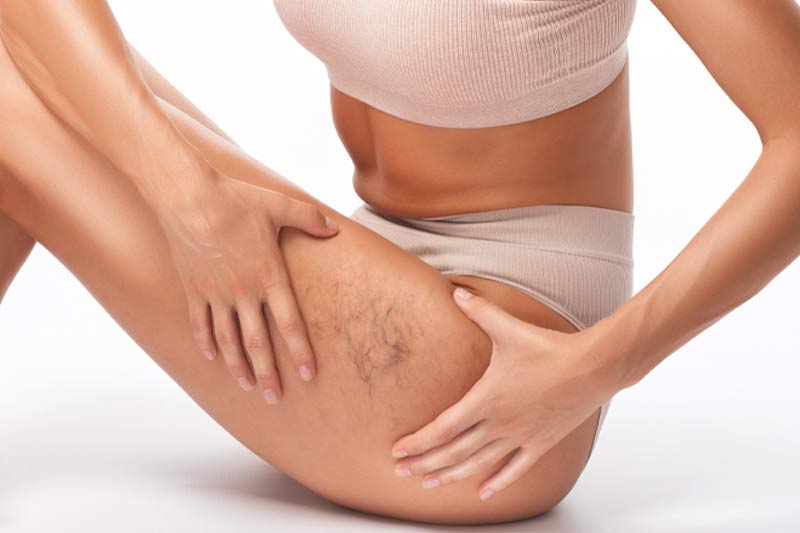Spider veins are small, thin lines that appear on the face and legs because of damaged veins. They are generally harmless but sometimes they cause tenderness in the affected area. That discomfort combined with an aesthetically displeasing appearance causes people to seek treatment for the condition.
Let’s look at what causes spider veins, what you can do to prevent them, and which treatments can help remove them.

What are Spider Veins
Spider veins are damaged veins that become visible underneath the skin. Unlike varicose veins, they are not bulgy, but flat and take the appearance of tree branches or spiderwebs. They are red, blue, or purple, and they typically appear on the legs, hands, arms, and face.
What Causes Spider Veins?
Healthy veins deliver deoxygenated blood to the heart. When veins weaken, some of the blood goes back in the opposite direction of the deoxygenated blood flow. This blood pools in the vein, puts pressure on the vein walls, and damages them causing the appearance of varicose or spider veins.
The following factors increase the chances of weak blood vessels and the development of spider veins:
- Genetics
- Aging
- Excess weight
- Sitting or standing for long periods
- Hormonal changes during puberty, pregnancy, or menopause
- Hormone therapy
- Sun exposure
- Certain medical conditions (blood clots, tumors, constipation)
How to Treat Spider Veins
Some lifestyle changes can prevent the appearance of spider veins. However, once they appear, you can undergo cosmetic treatments that reduce or eliminate spider veins.
Lifestyle Changes
Follow a few simple lifestyle habits to prevent or reduce spider veins. Maintain regular physical activity like light exercise or brisk walks to improve blood circulation. Achieving optimal weight may be difficult but is very important in reducing pressure in the veins. The simple practice of elevating your legs above the chest when you’re resting also helps. Likewise, take breaks when sitting or standing for long periods.
Compression (Support) Stockings
Compression stockings tighten the weakened veins, prevent blood from pooling, help your muscles move blood in the right direction, and reduce vein-related discomfort and swelling. Compression socks come in different sizes and styles.
For the best results, doctors recommend you wear them all day.
Sclerotherapy
Sclerotherapy is a medical procedure that involves injecting a chemical solution into spider veins. This causes the veins to collapse and prevents blood from flowing through them.
The treated veins clear up within a few weeks. You may need several treatments to eliminate spider veins.
The procedure lasts one or two hours and doesn’t require anesthesia. However, the patient needs to wear compression stockings and walk for at least 30 minutes every day for a few weeks after the treatment.
Book your Vibrant Skin Bar Sclerotherapy appointment online or call us at (480) 422-2058.
Laser Treatment
Laser therapy is effective for small spider veins that are very close to the skin. The medical provider uses a laser device to send light to the treated area. The light turns into heat in the blood vessel and damages it. The veins shrink and gradually disappear.
You may need several treatments to achieve full effects.
The treatment requires no downtime but doctors recommend wearing compression stockings after the procedure.
Endovenous Laser Therapy (EVLT)
EVLT requires the use of anesthesia because the medical provider makes a small incision in the treatment area and inserts a laser fiber in the vein. The laser heats the blood vessel and causes it to shrink and close shut, stopping blood flow. The spider vein disappears within one year.
After the treatment, you will need to wear compression stockings and take daily walks. For full effects, some patients need several treatments.
Radiofrequency Occlusion
Like EVLT, radiofrequency occlusion requires the use of anesthesia because the medical provider makes a small cut in the treated area. The provider inserts a catheter into the vein and activates a radiofrequency device that sends RF energy into the vein through the catheter. The heat causes the vein walls to collapse and close shut, preventing blood flow. The damaged veins gradually disappear, but some patients require more than one treatment.
Medical providers typically recommend radiofrequency occlusion for larger veins.
Surgery
Spider veins usually respond well to less invasive treatments like sclerotherapy and endovenous laser therapy. For this reason, medical providers don’t typically recommend surgery for spider veins, but only for larger varicose veins.
How to Prevent Spider Veins
We can’t change our genes or stop the aging process, but we do have control over other factors that weaken blood vessels. Follow these lifestyle habits to lower the chances of developing spider veins:
- Exercise at least half an hour every day
- Take daily walks
- Maintain optimal weight
- Elevate your legs whenever you can (while watching TV, reading…)
- Wear sunscreen outdoors
- Change positions every 30 minutes during work
- Avoid long hot baths
- Avoid high heels and tight clothing
When Should You Visit a Doctor?
In most cases, spider veins are medically harmless. However, if you experience any of the following, consult your doctor:
- Swollen spider veins
- Sores or rashes in the area around spider veins
- Debilitating pain
The doctor will examine your spider veins by looking them over or by performing an ultrasound. Make sure you disclose all information about your symptoms, your medical history, and what medications and supplements you are taking so that your doctor can determine the best treatment.
Conclusion
If spider veins are causing you discomfort or making you self-conscious about your appearance, consider some of the available treatments that effectively reduce or eliminate them. Don’t forget to also incorporate healthy lifestyle habits to prevent future issues with damaged veins.


